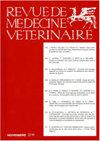Efecto del clorhidrato de clembuterol en la ganancia de peso y lesiones histológicas en ratones
Q2 Veterinary
引用次数: 1
Abstract
Clenbuterol hydrochloride (CLB) is a growth-promoting b-agonist in animals for supply, but its illicit use has generated repercussions on public health. A biological model with mice was developed to evaluate the effect of CLB on weight gain and histological lesions. Mice were fed rabbit meat, which was previously supplemented with CLB. Body weight was recorded 35 days post-exposure; muscular and serum concentration of CLB was obtained through the ELISA test, and tissues were collected from liver and heart for histopathological analysis. Values obtained from the experimental animals (G1 and G2) were analyzed by a completely randomized experimental design with two treatments (n = 10), subjected to an analysis of variance and comparison of means with the Tukey test (p < 0.05). There was an increase of 7 g in body weight in G1, compared to 4.0 g in G2. Liver weight was 2.58 g and 1.79, respectively (p < 0.05). In G1, CLB concentration in muscle was 5324 pg.g –1 , and 4378 pg.g –1 in blood serum. Only histological changes were observed in the tissues of G1 mice. Liver showed cellular swelling, moderate mitosis, pyknosis and hydropic degeneration; in addition, fiber thickening, pleomorphism and nuclear atypia were observed in the heart. CLB contributed to weight gain in exposed mice and caused structural alterations in liver and heart.盐酸克仑特罗对小鼠增重和组织学损伤的影响
盐酸盐酸克仑特罗(CLB)是一种供动物使用的促生长b激动剂,但其非法使用已对公共卫生产生影响。建立小鼠生物学模型,评价CLB对体重增加和组织病变的影响。小鼠喂食兔肉,兔肉之前添加了CLB。暴露后35 d记录体重;ELISA法测定大鼠肌肉及血清CLB浓度,并取肝、心组织进行组织病理学分析。实验动物(G1和G2)的数据采用两组处理(n = 10)的完全随机试验设计进行分析,采用方差分析和均数比较,采用Tukey检验(p < 0.05)。G1组体重增加7 g, G2组体重增加4.0 g。肝脏质量分别为2.58 g和1.79 g (p < 0.05)。G1期肌肉CLB浓度为5324 pg.g -1,血清CLB浓度为4378 pg.g -1。G1小鼠组织仅见组织学改变。肝脏表现为细胞肿胀、中度有丝分裂、固缩、积水变性;心肌纤维增厚、多形性及核异型性。CLB导致暴露的小鼠体重增加,并导致肝脏和心脏的结构改变。
本文章由计算机程序翻译,如有差异,请以英文原文为准。
求助全文
约1分钟内获得全文
求助全文
来源期刊

Revue De Medecine Veterinaire
农林科学-兽医学
CiteScore
1.30
自引率
0.00%
发文量
0
审稿时长
18-36 weeks
期刊介绍:
The Revue de Médecine Vétérinaire publishes four kinds of text:
1) Scientific reviews on subjects related to veterinary and comparative medicine. Suggested length: 10 to 30 typed pages.
2) Original reports on fundamental or applied research. Suggested length: 10 to 15 typed pages.
3) Continuous education articles, that should be easily understandable by non-specialists. Suggested length: 10 to 15 typed pages.
4) Clinical reports. Suggested length: 5 to 15 typed pages.
The publication can be done in French language or English language.
For an article written in English by not english native speakers authors, the manuscript must be subjected by attesting that it was read again by an anglophone scientist or a scientific translator.
The authors must certify that the manuscript was not published or subjected for publication to another review.
The manuscript must be accompanied by a sheet signed by all the joint authors indicating their agreement for the tender of the manuscript.
The publication is free but a financial participation could be required for the photographs color. An estimate will be sent to collect the agreement of the authors.
 求助内容:
求助内容: 应助结果提醒方式:
应助结果提醒方式:


